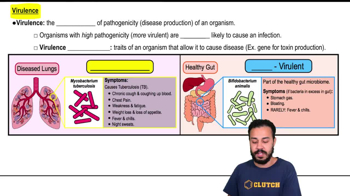Which of the following observations is not part of the theory of natural selection? a. Populations of organisms have more offspring than will survive; b. There is variation among individuals in a population; c. Modern organisms are unrelated; d. Traits can be passed on from parent to offspring; e. Some variants in a population have a higher probability of survival and reproduction than other variants do.
An Evolving Enemy
Chapter 12, Problem 1
What types of drugs have helped reduce the death rate due to tuberculosis infection, and why have they become less effective more recently?
 Verified step by step guidance
Verified step by step guidance1
Identify the types of drugs used to treat tuberculosis: The primary drugs used to treat tuberculosis (TB) are isoniazid, rifampin, ethambutol, and pyrazinamide. These drugs are often used in combination to effectively combat the TB bacteria, Mycobacterium tuberculosis.
Understand the mechanism of action of these drugs: Isoniazid and rifampin work by inhibiting the synthesis of mycolic acid, an essential component of the bacterial cell wall. Ethambutol interferes with cell wall synthesis by blocking the formation of arabinogalactan, while pyrazinamide disrupts membrane transport and energy production within the TB bacteria.
Examine the reasons for the reduced effectiveness of these drugs: The main reason for the reduced effectiveness of TB drugs is the emergence of drug-resistant strains of the TB bacteria. These strains have developed mutations that protect them against the standard drugs, making treatment more difficult.
Explore the types of drug resistance: There are two main types of drug-resistant TB: multidrug-resistant TB (MDR-TB), which is resistant to at least isoniazid and rifampin, and extensively drug-resistant TB (XDR-TB), which is resistant to isoniazid, rifampin, any fluoroquinolone, and at least one of three injectable second-line drugs.
Discuss the impact of drug resistance on treatment and control: The emergence of drug-resistant TB strains requires the use of second-line drugs, which are often less effective, more toxic, and more expensive than the first-line drugs. This complicates treatment regimens and increases the duration and cost of treatment, while also reducing the overall success rate of TB control programs.

Verified Solution
Video duration:
3mWas this helpful?
Key Concepts
Here are the essential concepts you must grasp in order to answer the question correctly.
Antibiotics and Antitubercular Drugs
Antitubercular drugs, such as isoniazid, rifampicin, ethambutol, and pyrazinamide, are antibiotics specifically designed to treat tuberculosis (TB). These drugs work by targeting the bacteria that cause TB, effectively reducing the infection and associated mortality rates. The combination of these medications is crucial for preventing the development of drug resistance.
Recommended video:
Guided course

Negative & Positive Controls
Drug Resistance in Tuberculosis
Drug resistance occurs when bacteria evolve and become less susceptible to the effects of medications. In the case of tuberculosis, the emergence of multidrug-resistant (MDR) and extensively drug-resistant (XDR) strains has significantly complicated treatment efforts. Factors contributing to resistance include incomplete treatment regimens, poor healthcare access, and the misuse of antibiotics.
Recommended video:
Guided course

Virulence
Public Health and TB Control Strategies
Effective public health strategies, such as vaccination (BCG vaccine), early detection, and directly observed therapy (DOT), are essential for controlling tuberculosis. These strategies aim to reduce transmission rates and ensure adherence to treatment, which is vital for preventing the spread of drug-resistant strains. However, challenges such as healthcare disparities and social determinants of health can hinder these efforts.
Recommended video:
Guided course

Specific Transcription Factors
Related Practice
Textbook Question
2674
views
Textbook Question
The best definition of evolutionary fitness is . a. physical health; b. the ability to attract members of the opposite sex; c. the ability to adapt to the environment; d. survival and reproduction relative to other members of the population e. overall strength
1425
views
Textbook Question
An adaptation is a trait of an organism that increases . a. its fitness; b. its ability to survive and replicate; c. in frequency in a population over many generations; d. A and B are correct; e. A, B, and C are correct
3673
views
